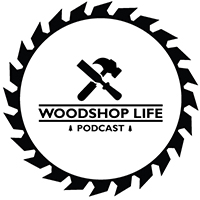Brians questions:
Gentlemen,
Thank you all for the time, effort, and expertise you put into the show. As many listeners have said before, it really is the best woodworking podcast out there!
As a beginning woodworker, I am curious about what projects you have done that helped you learn new skills or refine key foundational skills to progress along your woodworking journey? Perhaps there are some “benchmark projects” that take a woodworker from sloppy beginner to capable amateur and beyond towards fine craftsmen? Where do the common projects like a cutting board, a cabinet, a dining table or something else fall along that spectrum?
Thanks again for all you do in support of the woodworking community.
Kind regards,Evan
One of my close friends just had a baby. I wanted to make the new baby something, but I wasn’t sure what. I don’t have the time to make any piece of furniture, but I would like to make a little gift or two. Do any of you have ideas for small gifts that the baby could either use/play with, or something they could keep for a long time?Thanks Matthew
Hi all,
Hobbyist woodworker working out of his 1 1/2 car garage (it doesn’t quite fit two cars and I share it with house storage stuff). Mobility has been key for me when working. One thing I struggle with is that my garage floor is not level. There’s two different angles and it can be an issue at times. For example my small outfeed table can’t be level with my worksite table saw because at times they may not line up. My work bench is in a fixed location but can’t hold anything round as it might roll off if I have to use it.
Any advice for my workshop woes or any sort of leveling feet you might recommend? Since I move things around, leveling a tool or table each time I use it can be a pain. Lifting the end of the workbench doesn’t seem to create stability when I am hand planing wood or chiseling.
Thanks, Jose
Huy’s questions:
Hey all, love the podcast. Been listening for quite a while and always ready to take notes.
I have a bent lamination/ vaccum bag question. How do you handle epoxy squeeze out? Or any Glue for that matter? My last question is how long do I leave a bent lamination in the bag? Is there a rule of thumb?
I need a really rigid glue line for the tight 3in inside radius I am trying to achieve and think epoxy is my best bet. I’d rather not use urea resin.
I really appreciate the help. Casey the maker
Hey guys: I’m a loyal listener and am very grateful for all the great info you share. I have a finishing question for you. I make wood fishing nets for family and friends and might want to make a business of it. I have been using spar varnish as a finish which looks great but is a pain to apply (I brush it on), takes forever to dry and always seems to be a bit soft even when fully dry. Is there an alternate finish I could consider that would be easy to apply. I am willing to invest in a spray system to up my finish game so that’s not a limitation. Important to note is that I use walnut in all my nets. In episode 115 I learned that walnut will turn orange in the sun- something I didn’t know. So will the suggested finish have UV protection or will I need to dye the walnut to ensure it maintains it’s brown color after sitting on the bottom of a boat for many seasons. Thanks again for spending your precious time educating the less knowledgeable.
Liam, Indianapolis
Hey Guy, and other guys.
How many pocket holes/Screws do you actually need?
I watch people on youtube building stuff with pocket holes and 9 times out of 10 I think to myself, “Surely that doesn’t need that many pocket holes.” I see guys building something like an end table or maybe a small piece of shop furniture and inevitably they use about 17 to 239 in this relatively small piece of wood and I just don’t understand it. Would love to hear the logic or what the general recommendation is. Jacob
